Effects of N Fertilizer Application on Soil N2O Emissions and CH4 Uptake: A Two-Year Study in an Apple Orchard in Eastern China
Abstract
:1. Introduction
2. Experiments
2.1. Site Description
2.2. Experimental Design
2.3. Measurement of N2O and CH4 Fluxes
2.4. Ancillary Measurements
2.5. Statistical Analysis
3. Results
3.1. Climate, Soil Temperature, and WFPS
3.2. Soil DOC, NH4+ and NO3− Content
3.3. Apple Production
3.4. N2O Fluxes
3.5. Annual N2O Emissions and EFd
3.6. CH4 Uptake
4. Discussion
5. Conclusions
Acknowledgments
Author Contributions
Conflicts of Interest
References
- Team, C.W.; Pachauri, R.K.; Meyer, L.A. IPCC, 2014: Climate Change 2014: Synthesis Report. Contribution of Working Groups I, II and III to the Fifth Assessment Report of the Intergovernmental Panel on Climate Change; IPCC: Geneva, Switzerland, 2014; p. 151. [Google Scholar]
- Smith, P.; Martino, D.; Cai, Z.; Gwary, D.; Janzen, H.; Kumar, P.; McCarl, B.; Ogle, S.; O’Mara, F.; Rice, C.; et al. Greenhouse gas mitigation in agriculture. Philos. Trans. R. Soc. B 2008, 363, 789–813. [Google Scholar] [CrossRef] [PubMed]
- Davidson, E.A. The contribution of manure and fertilizer nitrogen to atmospheric nitrous oxide since 1860. Nat. Geosci. 2009, 2, 659–662. [Google Scholar] [CrossRef]
- Syakila, A.; Kroeze, C. The global nitrous oxide budget revisited. Greenh. Gas Meas. Manag. 2011, 1, 17–26. [Google Scholar] [CrossRef]
- Firestone, M.; Davidson, E. Microbiological basis of NO and N2O production and consumption in soil. In Exchange of Trace Gases between Terrestrial Ecosystems and the Atmosphere; John Wiley and Sons Ltd.: Hoboken, NJ, USA, 1989; pp. 7–21. [Google Scholar]
- Wrage, N.; Velthof, G.L.; van Beusichem, M.L.; Oenema, O. Role of nitrifier denitrification in the production of nitrous oxide. Soil Biol. Biochem. 2001, 33, 1723–1732. [Google Scholar] [CrossRef]
- Linn, D.M.; Doran, J.W. Effect of water-filled pore space on carbon dioxide and nitrous oxide production in tilled and nontilled soils. Soil Sci. Soc. Am. J. 1984, 48, 1267–1272. [Google Scholar] [CrossRef]
- Bateman, E.J.; Baggs, E.M. Contributions of nitrification and denitrification to N2O emissions from soils at different water-filled pore space. Biol. Fertil. Soils 2005, 41, 379–388. [Google Scholar] [CrossRef]
- Matson, P.A.; Naylor, R.; Ortiz-Monasterio, I. Integration of environmental, agronomic, and economic aspects of fertilizer management. Science 1998, 280, 112–115. [Google Scholar] [CrossRef] [PubMed]
- Liu, C.; Zheng, X.; Zhou, Z.; Han, S.; Wang, Y.; Wang, K.; Liang, W.; Li, M.; Chen, D.; Yang, Z. Nitrous oxide and nitric oxide emissions from an irrigated cotton field in Northern China. Plant Soil 2010, 332, 123–134. [Google Scholar] [CrossRef]
- Gu, J.; Nicoullaud, B.; Rochette, P.; Pennock, D.J.; Henault, C.; Cellier, P.; Richard, G. Effect of topography on nitrous oxide emissions from winter wheat fields in Central France. Environ. Pollut. 2011, 159, 3149–3155. [Google Scholar] [CrossRef] [PubMed]
- Gu, J.; Nicoullaud, B.; Rochette, P.; Grossel, A.; Henault, C.; Cellier, P.; Richard, G. A regional experiment suggests that soil texture is a major control of N2O emissions from tile-drained winter wheat fields during the fertilization period. Soil Biol. Biochem. 2013, 60, 134–141. [Google Scholar] [CrossRef]
- Garland, G.M.; Suddick, E.; Burger, M.; Horwath, W.R.; Six, J. Direct N2O emissions from a Mediterranean vineyard: Event-related baseline measurements. Agric. Ecosyst. Environ. 2014, 195, 44–52. [Google Scholar] [CrossRef]
- Decock, C.; Garland, G.; Suddick, E.C.; Six, J. Season and location-specific nitrous oxide emissions in an almond orchard in California. Nutr. Cycl. Agroecosyst. 2017, 107, 139–155. [Google Scholar] [CrossRef]
- Bouwman, A.F. Direct emission of nitrous oxide from agricultural soils. Nutr. Cycl. Agroecosyst. 1996, 46, 53–70. [Google Scholar] [CrossRef]
- Zou, J.; Huang, Y.; Zheng, X.; Wang, Y. Quantifying direct N2O emissions in paddy fields during rice growing season in mainland China: Dependence on water regime. Atmos. Environ. 2007, 41, 8030–8042. [Google Scholar] [CrossRef]
- Webb, J.; Thorman, R.E.; Fernanda-Aller, M.; Jackson, D.R. Emission factors for ammonia and nitrous oxide emissions following immediate manure incorporation on two contrasting soil types. Atmos. Environ. 2014, 82, 280–287. [Google Scholar] [CrossRef]
- Zheng, X.H.; Han, S.H.; Huang, Y.; Wang, Y.S.; Wang, M.X. Re-quantifying the emission factors based on field measurements and estimating the direct N2O emission from Chinese croplands. Glob. Biogeochem. Cycles 2004, 18. [Google Scholar] [CrossRef]
- IPCC 2006. 2006 IPCC Guidelines for National Greenhouse Gas Inventories–A Primer, Prepared by the National Greenhouse Gas Inventories Programme; Eggleston, H.S., Buendia, L., Miwa, K., Ngara, T., Tanabe, K., Eds.; IGES: Hayama, Japan, 2006. [Google Scholar]
- Stehfest, E.; Bouwman, L. N2O and NO emission from agricultural fields and soils under natural vegetation: Summarizing available measurement data and modeling of global annual emissions. Nutr. Cycl. Agroecosyst. 2006, 74, 207–228. [Google Scholar] [CrossRef]
- Shepherd, A.; Yan, X.; Nayak, D.; Newbold, J.; Moran, D.; Dhanoa, M.S.; Goulding, K.; Smith, P.; Cardenas, L.M. Disaggregated N2O emission factors in China based on cropping parameters create a robust approach to the IPCC Tier 2 methodology. Atmos. Environ. 2015, 122, 272–281. [Google Scholar] [CrossRef] [PubMed] [Green Version]
- Berdanier, A.B.; Conant, R.T. Regionally differentiated estimates of cropland N2O emissions reduce uncertainty in global calculations. Glob. Chang. Biol. 2012, 18, 928–935. [Google Scholar] [CrossRef]
- Mosier, A.; Schimel, D.; Valentine, D.; Bronson, K.; Parton, W. Methane and nitrous-oxide fluxes in native, fertilized and cultivated grasslands. Nature 1991, 350, 330–332. [Google Scholar] [CrossRef]
- Liu, X.; Zhang, Q.; Li, S.; Zhang, L.; Ren, J. Simulated NH4+-N Deposition Inhibits CH4 Uptake and Promotes N2O Emission in the Meadow Steppe of Inner Mongolia, China. Pedosphere 2017, 27, 306–317. [Google Scholar] [CrossRef]
- Ju, X.T.; Liu, X.J.; Zhang, F.S.; Roelcke, M. Nitrogen fertilization, soil nitrate accumulation, and policy recommendations in several agricultural regions of China. Ambio 2004, 33, 300–305. [Google Scholar] [CrossRef] [PubMed]
- Zhai, H.; Dachuang, S.; Huairui, S. Current status and developing trend of apple industry in China. J. Fruit Sci. 2007, 24, 355–360. (In Chinese) [Google Scholar]
- Ju, X.T.; Kou, C.L.; Zhang, F.S.; Christie, P. Nitrogen balance and groundwater nitrate contamination: Comparison among three intensive cropping systems on the North China Plain. Environ. Pollut. 2006, 143, 117–125. [Google Scholar] [CrossRef] [PubMed] [Green Version]
- Ma, L.; Velthof, G.L.; Wang, F.H.; Qin, W.; Zhang, W.F.; Liu, Z.; Zhang, Y.; Wei, J.; Lesschen, J.P.; Ma, W.Q.; et al. Nitrogen and phosphorus use efficiencies and losses in the food chain in China at regional scales in 1980 and 2005. Sci. Total Environ. 2012, 434, 51–61. [Google Scholar] [CrossRef] [PubMed]
- Hoben, J.P.; Gehl, R.J.; Millar, N.; Grace, P.R.; Robertson, G.P. Nonlinear nitrous oxide (N2O) response to nitrogen fertilizer in on-farm corn crops of the US Midwest. Glob. Chang. Biol. 2011, 17, 1140–1152. [Google Scholar] [CrossRef]
- Chen, X.; Cui, Z.; Fan, M.; Vitousek, P.; Zhao, M.; Ma, W.; Wang, Z.; Zhang, W.; Yan, X.; Yang, J.; et al. Producing more grain with lower environmental costs. Nature 2014, 514, 486–489. [Google Scholar] [CrossRef] [PubMed]
- Liu, H.; Zhao, P.; Lu, P.; Wang, Y.S.; Lin, Y.B.; Rao, X.Q. Greenhouse gas fluxes from soils of different land-use types in a hilly area of South China. Agric. Ecosyst. Environ. 2008, 124, 125–135. [Google Scholar] [CrossRef]
- Pang, J.; Wang, X.; Mu, Y.; Ouyang, Z.; Liu, W. Nitrous oxide emissions from an apple orchard soil in the semiarid Loess Plateau of China. Biol. Fertil. Soils 2009, 46, 37–44. [Google Scholar] [CrossRef]
- Lin, S.; Iqbal, J.; Hu, R.; Ruan, L.; Wu, J.; Zhao, J.; Wang, P. Differences in nitrous oxide fluxes from red soil under different land uses in mid-subtropical China. Agric. Ecosyst. Environ. 2012, 146, 168–178. [Google Scholar] [CrossRef]
- Alsina, M.M.; Fanton-Borges, A.C.; Smart, D.R. Spatiotemporal variation of event related N2O and CH4 emissions during fertigation in a California almond orchard. Ecosphere 2013, 4. [Google Scholar] [CrossRef]
- Fentabil, M.M.; Nichol, C.F.; Jones, M.D.; Neilsen, G.H.; Neilsen, D.; Hannam, K.D. Effect of drip irrigation frequency, nitrogen rate and mulching on nitrous oxide emissions in a semi-arid climate: An assessment across two years in an apple orchard. Agric. Ecosyst. Environ. 2016, 235, 242–252. [Google Scholar] [CrossRef]
- De Klein, C.A.M.; Harvey, M.J. Nitrous Oxide Chamber Methodology Guidelines; Livestock Research Group: London, UK, 2013. [Google Scholar]
- Parkin, T.B. Effect of sampling frequency on estimates of cumulative nitrous oxide emissions. J. Environ. Qual. 2008, 37, 1390–1395. [Google Scholar] [CrossRef] [PubMed]
- Reeves, S.; Wang, W.; Salter, B.; Halpin, N. Quantifying nitrous oxide emissions from sugarcane cropping systems: Optimum sampling time and frequency. Atmos. Environ. 2016, 136, 123–133. [Google Scholar] [CrossRef]
- Zheng, X.H.; Mei, B.L.; Wang, Y.H.; Xie, B.H.; Wang, Y.S.; Dong, H.B.; Xu, H.; Chen, G.X.; Cai, Z.C.; Yue, J.; et al. Quantification of N2O fluxes from soil-plant systems may be biased by the applied gas chromatograph methodology. Plant Soil 2008, 311, 211–234. [Google Scholar] [CrossRef]
- Kroon, P.; Hensen, A.; van den Bulk, W.C.M.; Jongejan, P.; Vermeulen, A. The importance of reducing the systematic error due to non-linearity in N2O flux measurements by static chambers. Nutr. Cycl. Agroecosyst. 2008, 82, 175–186. [Google Scholar] [CrossRef]
- Mei, B.; Zheng, X.; Xie, B.; Dong, H.; Yao, Z.; Liu, C.; Zhou, Z.; Wang, R.; Deng, J.; Zhu, J. Characteristics of multiple-year nitrous oxide emissions from conventional vegetable fields in southeastern China. J. Geophys. Res. Atmos. 2011, 116. [Google Scholar] [CrossRef]
- Chang, C.; Janzen, H.; Cho, C. Nitrous oxide emission from long-term manured soils. Soil Sci. Soc. Am. J. 1998, 6, 677–682. [Google Scholar] [CrossRef]
- Gu, J.; Zheng, X.; Wang, Y.; Ding, W.; Zhu, B.; Chen, X.; Wang, Y.; Zhao, Z.; Shi, Y.; Zhu, J. Regulatory effects of soil properties on background N2O emissions from agricultural soils in China. Plant Soil 2007, 295, 53–65. [Google Scholar] [CrossRef]
- Gu, J.; Zheng, X.; Zhang, W. Background nitrous oxide emissions from croplands in China in the year 2000. Plant Soil 2009, 320, 307–320. [Google Scholar] [CrossRef]
- Li, X.; Hu, C.; Delgado, J.A.; Zhang, Y.; Ouyang, Z. Increased nitrogen use efficiencies as a key mitigation alternative to reduce nitrate leaching in north China plain. Agric. Water Manag. 2007, 89, 137–147. [Google Scholar] [CrossRef]
- National Bureau of Statistics of China. China Statistical Yearbook; China Statistics Press: Beijing, China, 2016; pp. 390–418. ISBN 9787503779176.
- Qu, Z.; Wang, J.; Almoy, T.; Bakken, L.R. Excessive use of nitrogen in Chinese agriculture results in high N2O/(N2O+N2) product ratio of denitrification, primarily due to acidification of the soils. Glob. Chang. Biol. 2014, 20, 1685–1698. [Google Scholar] [CrossRef] [PubMed]
- Chen, X.-P.; Cui, Z.-L.; Vitousek, P.M.; Cassman, K.G.; Matson, P.A.; Bai, J.-S.; Meng, Q.-F.; Hou, P.; Yue, S.-C.; Roemheld, V.; et al. Integrated soil-crop system management for food security. Proc. Natl. Acad. Sci. USA 2011, 108, 6399–6404. [Google Scholar] [CrossRef] [PubMed]
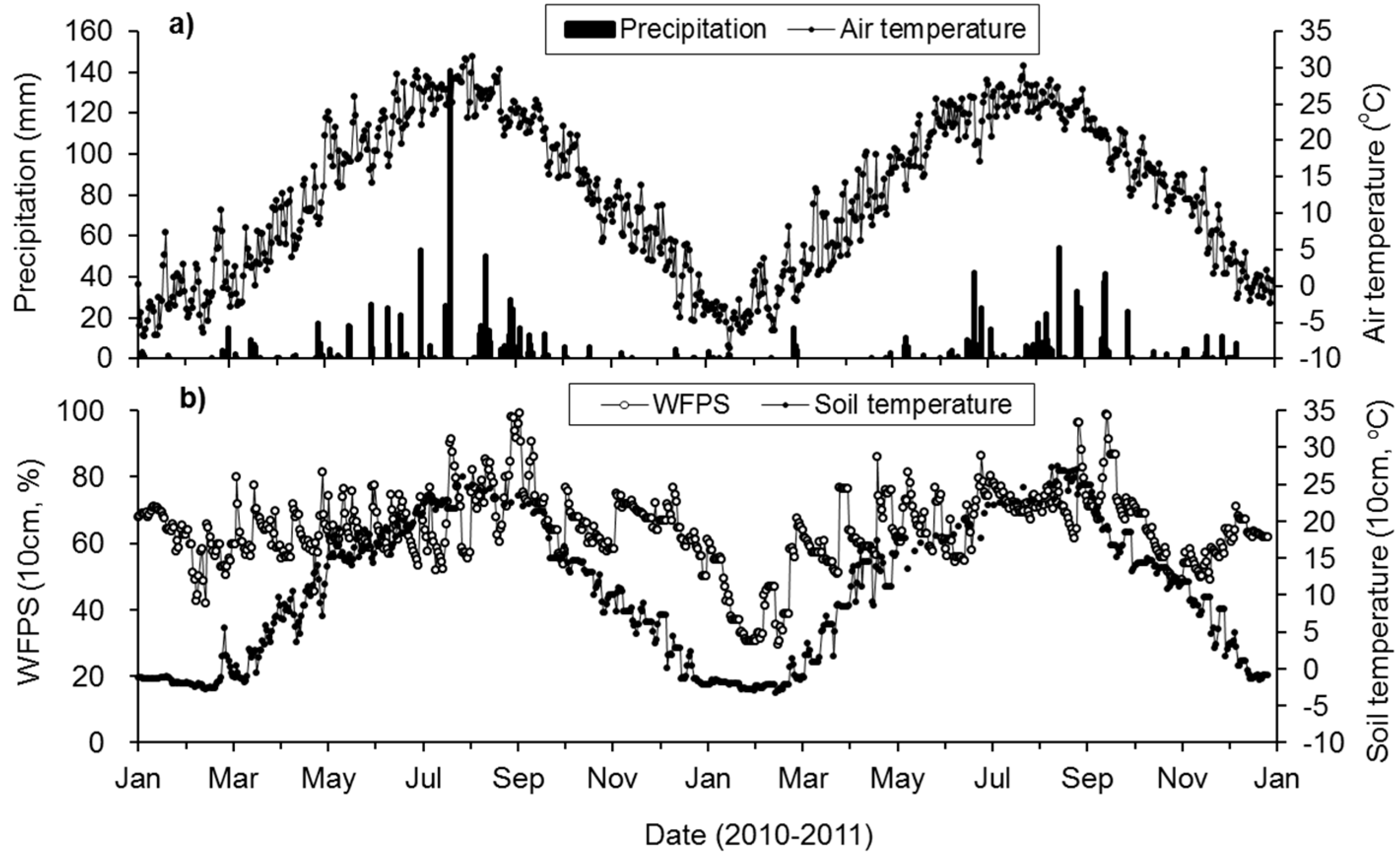
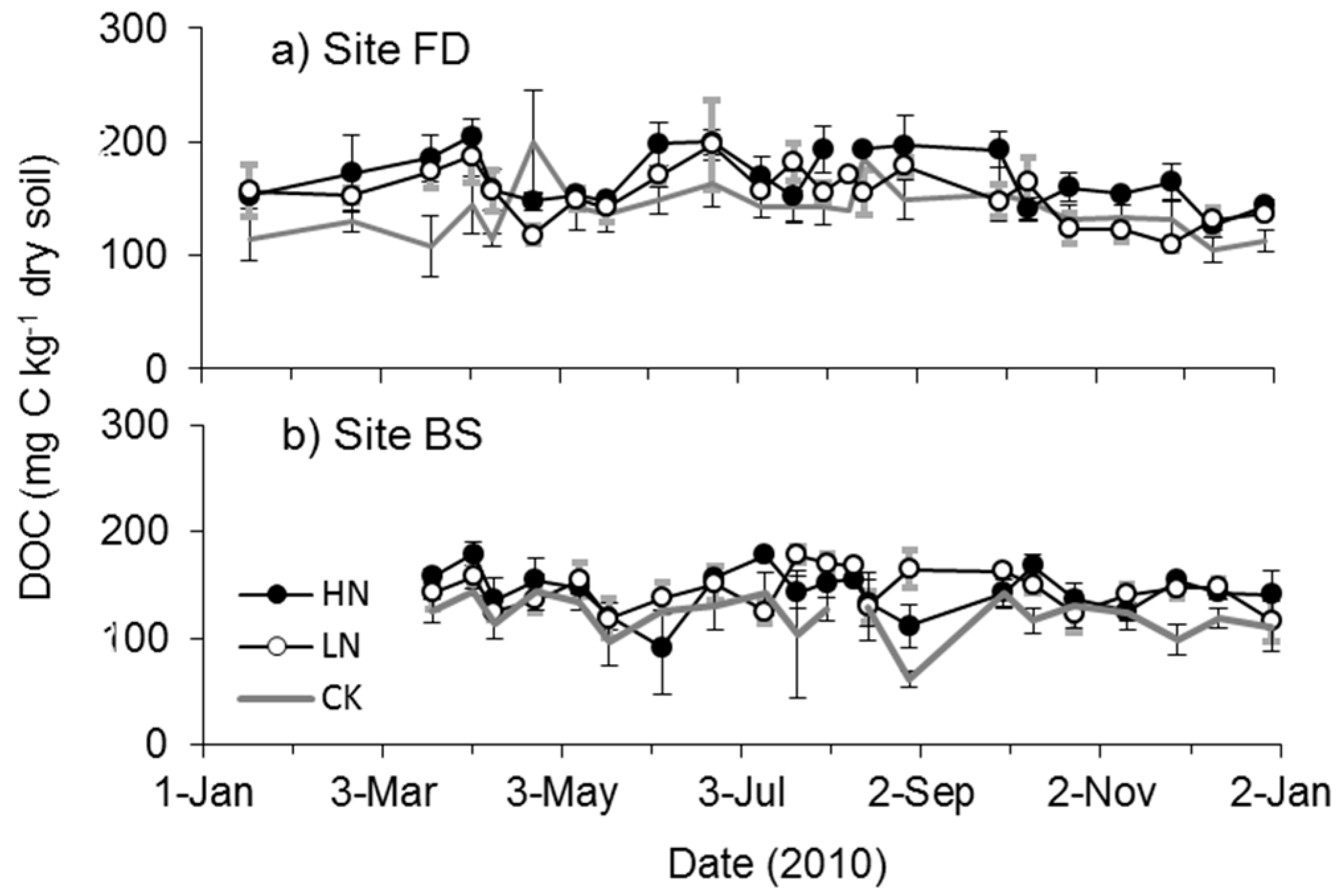
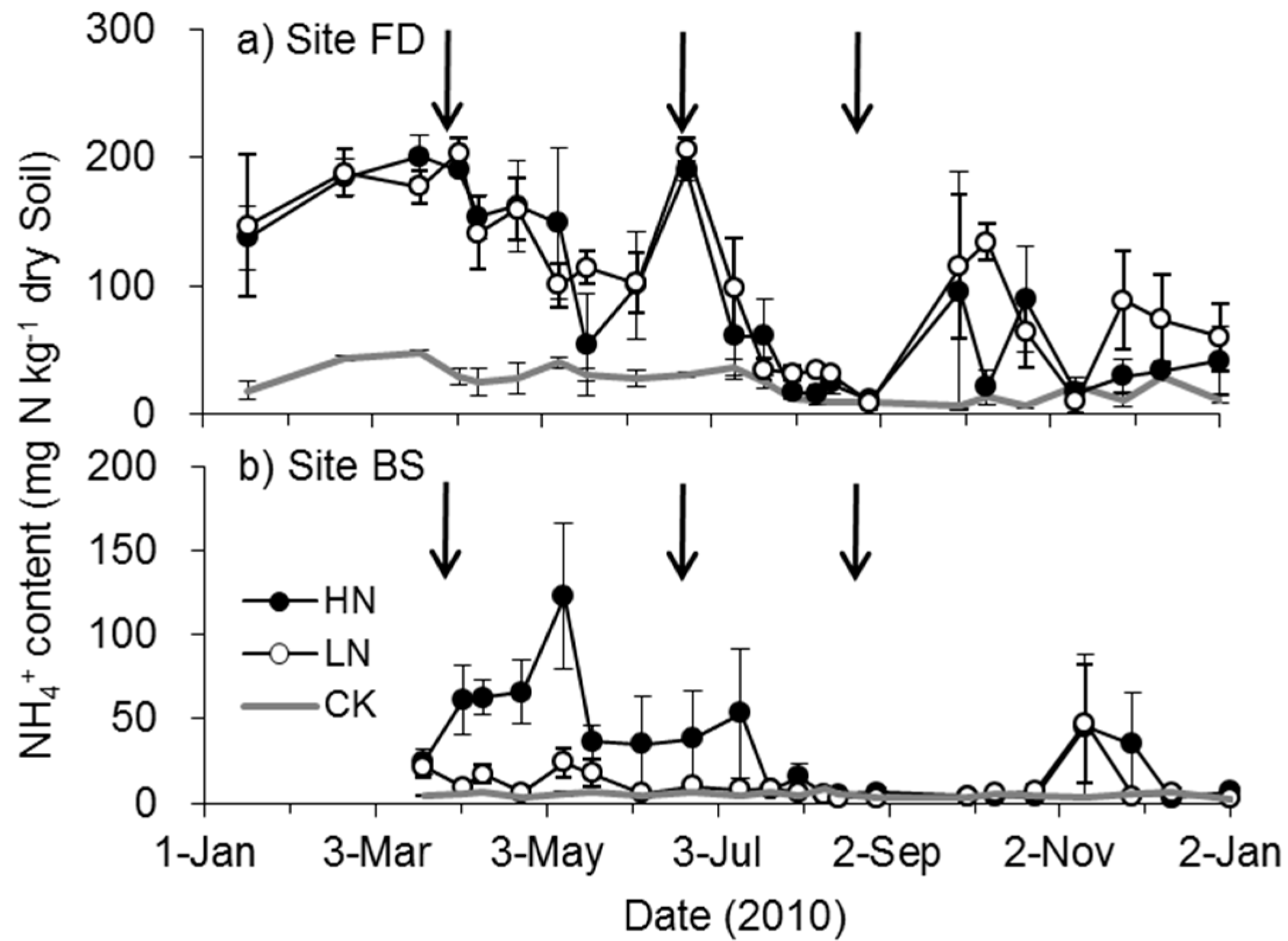
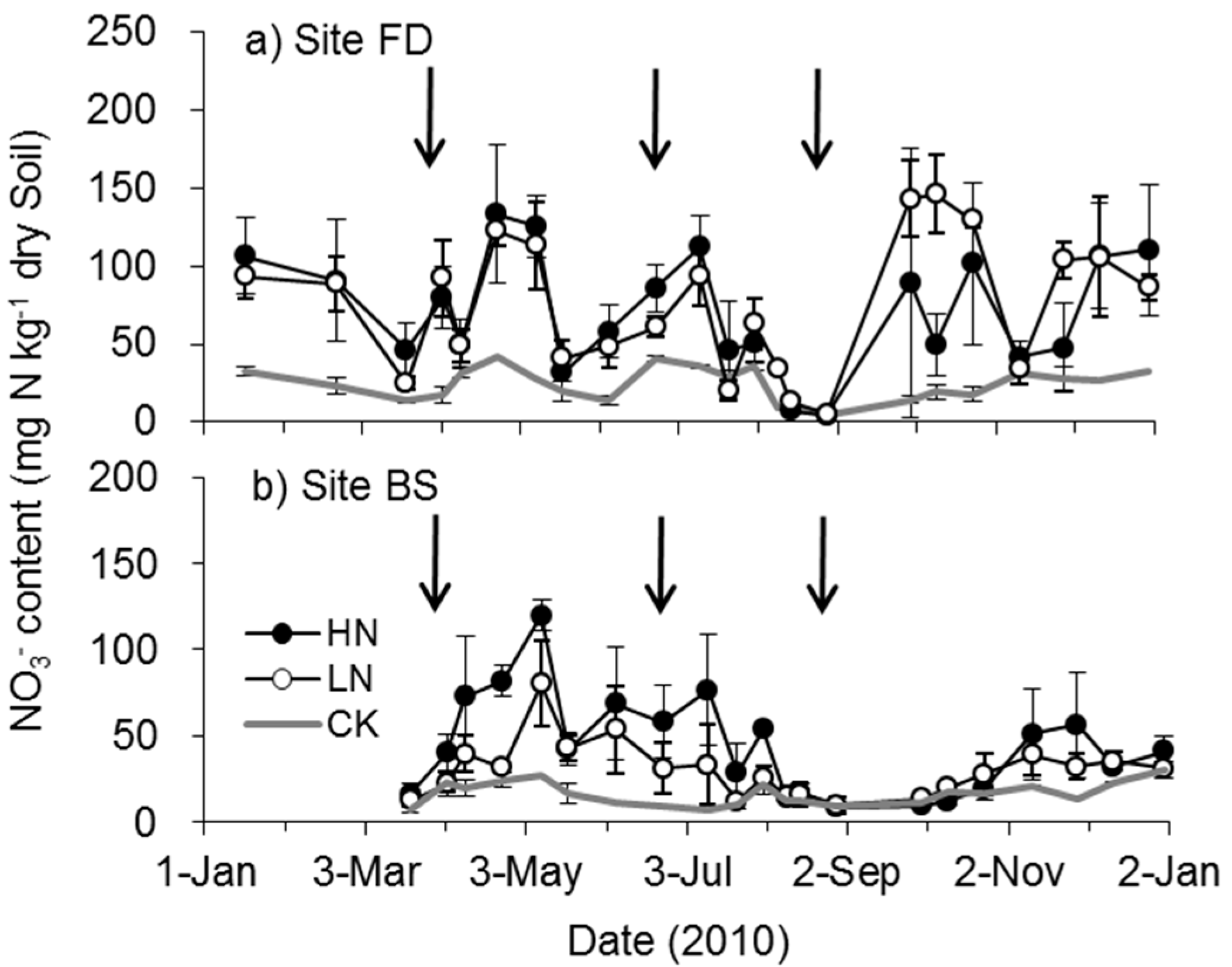
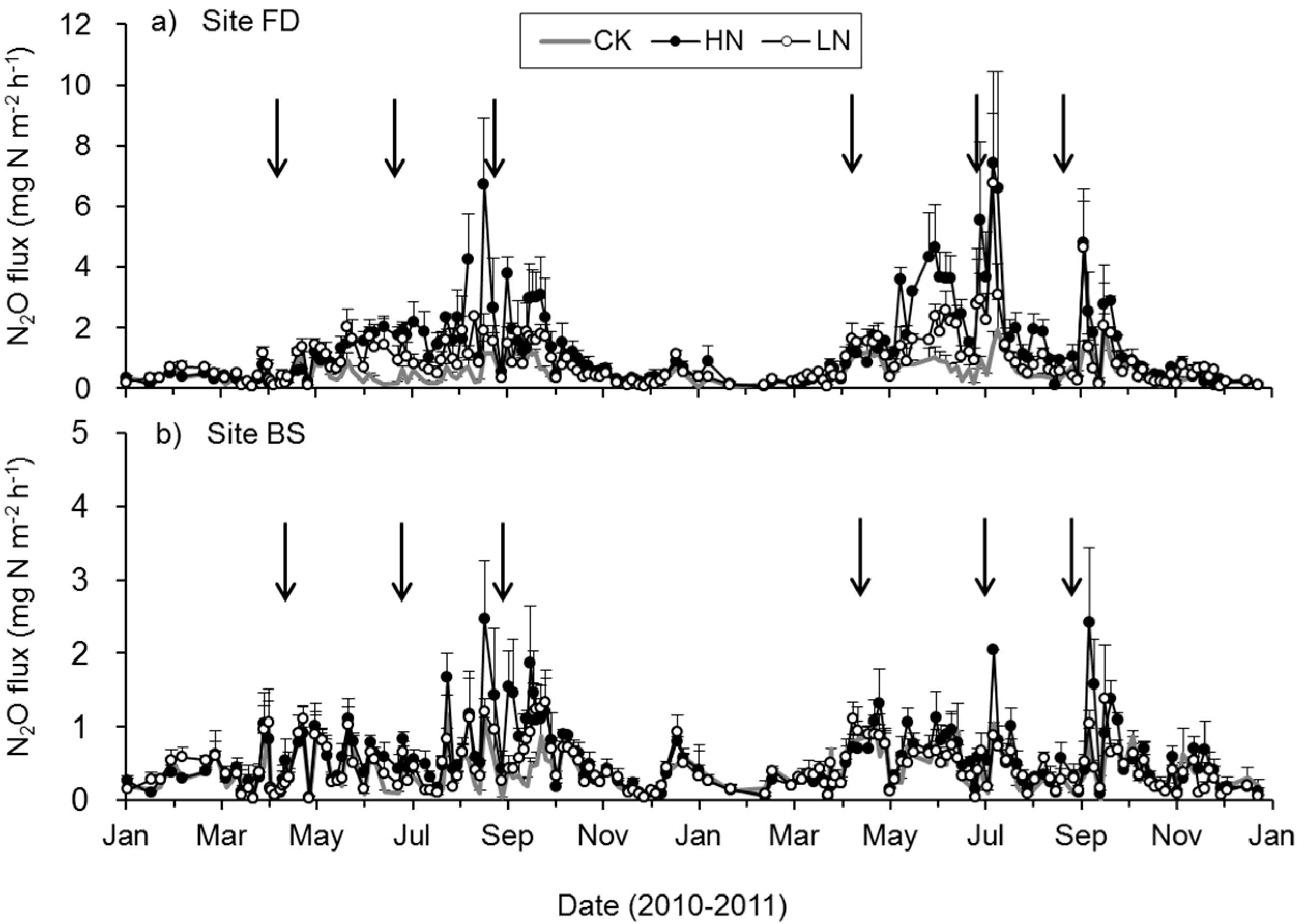
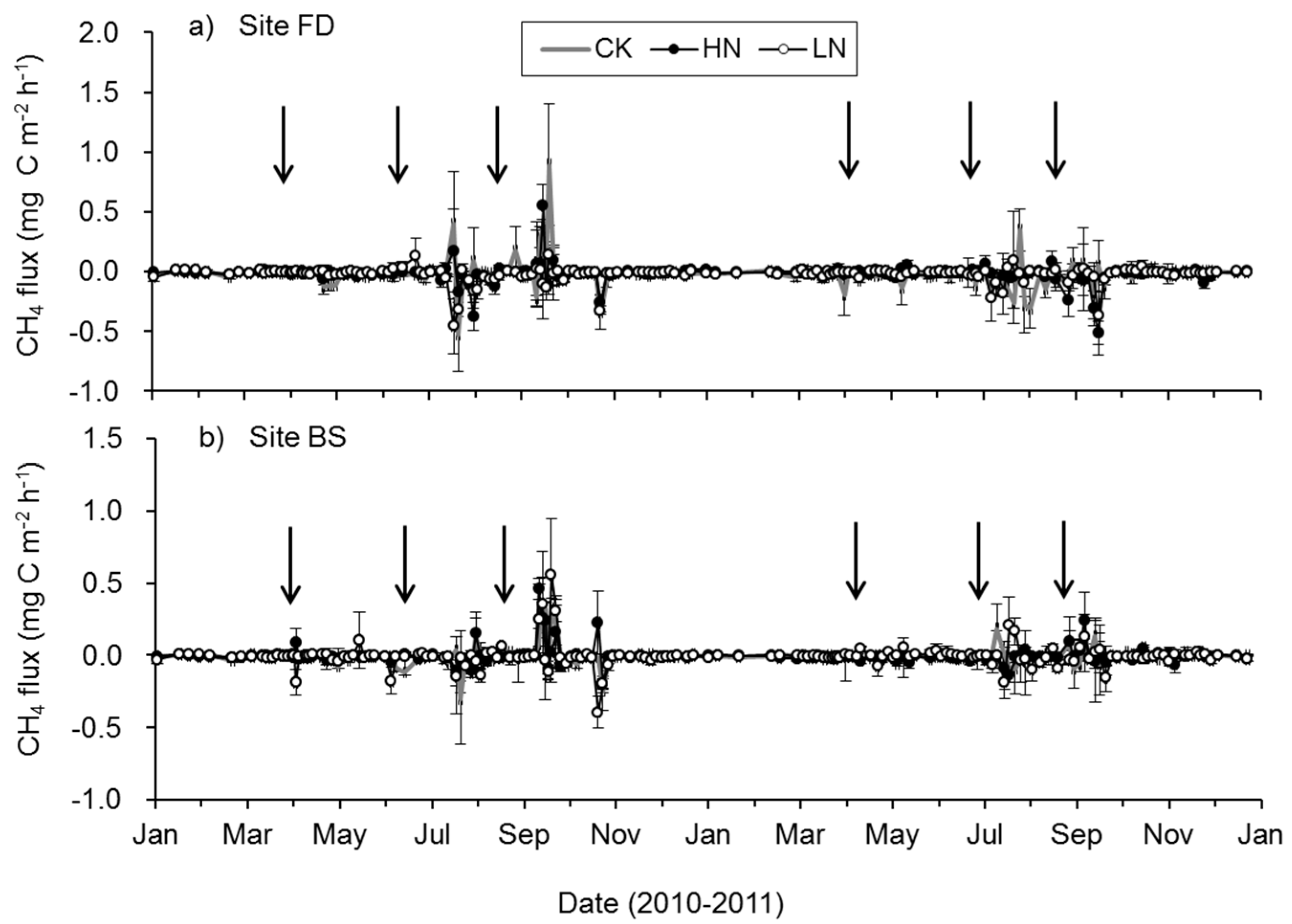
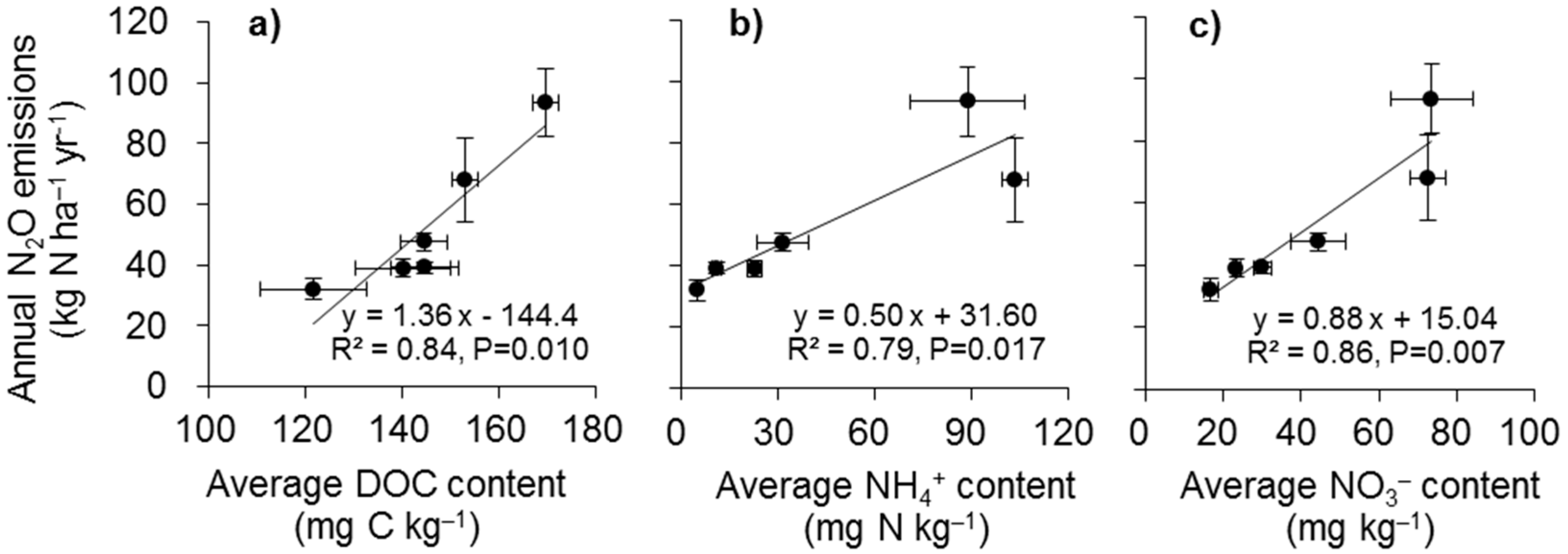
| Soil Properties | Mean |
|---|---|
| pH (H2O) | 6.7 |
| Bulk density (g cm−3) | 1.39 |
| Soil organic carbon (g C kg−1) | 10.6 |
| Total nitrogen (g N kg−1) | 1.2 |
| Total phosphorus (g P kg−1) | 1.9 |
| Total potassium (g K kg−1) | 15.8 |
| Available phosphorus (mg P kg−1) | 50.7 |
| Available potassium (mg K kg−1) | 155.2 |
| Clay (<2 µm, %) | 7.0 |
| Silt (2–200 µm, %) | 39.6 |
| Sand (>200 µm, %) | 53.4 |
| Year | Fertilization Date | Method | Fertilizer | Date of Irrigation |
|---|---|---|---|---|
| 2010 | 1 April | Buried in ditches | 50% N | 11 May; 2 August; 1 October; 13 November; 7 December |
| 100% P | ||||
| 50% K | ||||
| 24 June | Surface application | 15% N | ||
| 22 August | Surface application | 35% N | ||
| 50% K | ||||
| 2011 | 1 April | Buried in ditches | 50% N | 27 March; 20 April; 27 May |
| 100% P | ||||
| 50% K | ||||
| 24 June | Surface application | 15% N | ||
| 22 August | Surface application | 35% N | ||
| 50% K |
| Year | Treatment | Production (t ha−1) | N2O (kg N ha−1 Year−1) | EFd (%) | CH4 (kg C ha−1 Year−1) | ||
|---|---|---|---|---|---|---|---|
| FD | BS | Field | Field | ||||
| 2010 | CK | 26.2 (2.4)a | 39.1 (2.0)a | 32.1 (3.5)a | 34.1 (3.1)a | - | −0.9 (0.4)a |
| LN | 31.2 (5.1)a | 68.2 (13.7)ab | 39.2 (1.9)ab | 47.2 (5.2)b | 1.65 | −1.1 (0.6)a | |
| HN | 30.2 (0.8)a | 93.6 (11.3)b | 47.6 (2.9)b | 60.3 (5.2)c | 1.46 | −0.4 (0.7)a | |
| 2011 | CK | 27.1 (2.6)a | 43.1 (1.1)a | 30.9 (3.4)a | 34.3 (2.7)a | - | −1.1 (0.6)a |
| LN | 35.6 (1.8)b | 77.1 (12.3)ab | 33.7 (3.8)a | 45.7 (6.1)b | 1.00 | −1.1 (0.4)a | |
| HN | 30.9 (3.3)ab | 112.7 (14.2)b | 38.7 (5.4)a | 59.2 (7.8)c | 1.24 | −0.7 (0.2)a | |
© 2017 by the authors. Licensee MDPI, Basel, Switzerland. This article is an open access article distributed under the terms and conditions of the Creative Commons Attribution (CC BY) license (http://creativecommons.org/licenses/by/4.0/).
Share and Cite
Xie, B.; Gu, J.; Yu, J.; Han, G.; Zheng, X.; Xu, Y.; Lin, H. Effects of N Fertilizer Application on Soil N2O Emissions and CH4 Uptake: A Two-Year Study in an Apple Orchard in Eastern China. Atmosphere 2017, 8, 181. https://doi.org/10.3390/atmos8100181
Xie B, Gu J, Yu J, Han G, Zheng X, Xu Y, Lin H. Effects of N Fertilizer Application on Soil N2O Emissions and CH4 Uptake: A Two-Year Study in an Apple Orchard in Eastern China. Atmosphere. 2017; 8(10):181. https://doi.org/10.3390/atmos8100181
Chicago/Turabian StyleXie, Baohua, Jiangxin Gu, Junbao Yu, Guangxuan Han, Xunhua Zheng, Yu Xu, and Haitao Lin. 2017. "Effects of N Fertilizer Application on Soil N2O Emissions and CH4 Uptake: A Two-Year Study in an Apple Orchard in Eastern China" Atmosphere 8, no. 10: 181. https://doi.org/10.3390/atmos8100181





